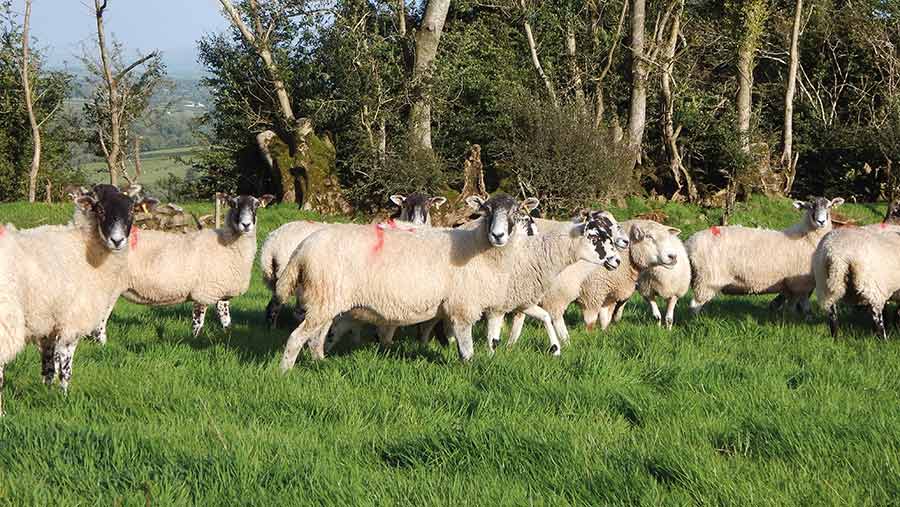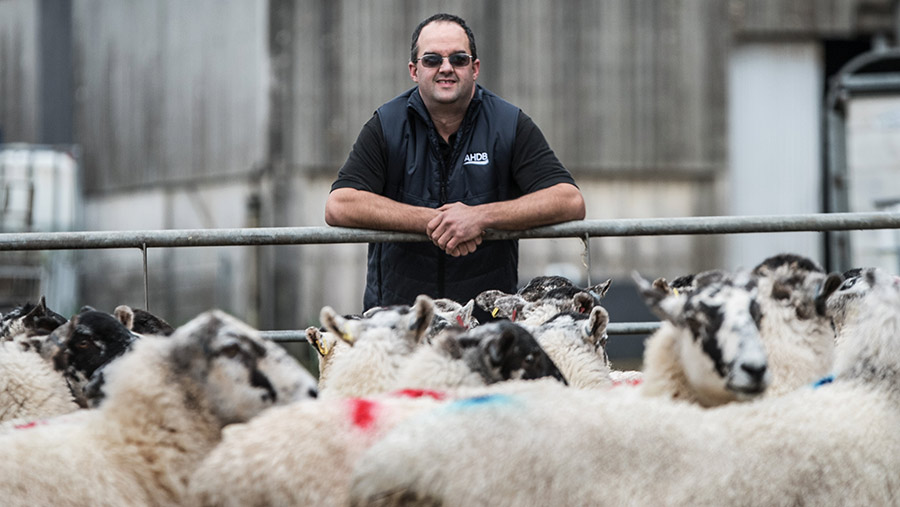How a Cornish farm is increasing lamb value using EBVs
 © AHDB
© AHDB Putting a focus on traits rather than the breed of his terminal sires has helped Adrian Coombe increase flock productivity at Dupath Farm, near Callington.
A project using estimated breeding values (EBVs) to select sires showed a net value difference of £4.30 a lamb between progeny groups sired by the highest and lowest indexing rams on Mr Coombe’s farm.
See also: EBV proven rams can add £6 a lamb, project shows
Farm facts
Dupath Farm, Callington, Cornwall
- 154ha (380-acre) mixed farm comprising beef and sheep enterprises as well as cereals and potatoes
- 620-head North Country mules (500 ewes and 120 ewe lambs)
- Ewe lambs bought in annually from a single source in Skipton
- Indoor lambing from end of February/beginning of March
- First lambs sold in June, majority as deadweight through Dunbia
- Part of the RamCompare project since 2017
The farm is home to 500 North Country Mules and 120 ewe lambs, as well as 180 head of dairy-bred Aberdeen Angus cattle.
Livestock are reared on a rotational grazing system across 154ha (380 acres) on the Devon-Cornwall border.
Lambs are born indoors at the end of February/early March and are finished off on grass – at about 43kg liveweight – and sold as deadweight, largely through Dunbia.
Breeding efficiency

Adrian Coombe © AHDB
In 2017, Mr Coombe began looking into the potential of using EBVs to select sires as a way to improve his breeding efficiency.
“I was dabbling with EBVs, and I didn’t totally understand them – I was reading the AHDB manuals and just starting to explore the use of them,” he said.
“And then RamCompare came along, which was using EBVs as part of the system, so it seemed like a good opportunity to use high genetic-merit tups on our flock to work out what was best for us and our system.”
For Mr Coombe, the biggest benefit of using recorded sires is having a more accurate picture of what he will be getting from them.
“[As part of the trial] we’ve had some grass-based tups here in the past that you probably wouldn’t have bought in a market.
“But they’ve come here, performed extremely well and turned out to be near the top of the table for certain traits.”
Ram selection
As a RamCompare farm, sires are selected for Mr Coombe, however, he says he does have some input. “If there is one [ram] I definitely don’t want then I can refuse it.”
This decision to reject or accept is based purely on the ram’s EBVs, he adds.
When selecting a ram, his focus is on targeting high growth and eight-week weights, good muscle depth and speed of finishing.
Over the past few years, Mr Coombe has tried a number of terminal sire breeds and tended to lean towards Charollais.
However, this year, he has seen best results using Meatlinc sires from breeders Clive and Jenny Richardson, who farm 250ha (620 acres) at Higher Denzell Farm, St Mawgan, Cornwall.
“We were introduced to the Richardsons through RamCompare – I didn’t know anything about the Meatlinc breed at all before,” explains Mr Coombe. “Traditionally, we were all Charollais [sired].”
With more than 20 years of experience with the Meatlinc breed, the Richardsons have collected a wealth of data on their rams, which they sell mainly to private customers who are particularly interested in using data-backed stock.
“We started off with Henry Fell, who founded the Meatlinc breed, back in 2000. We’ve indexed and recorded everything since,” explains Mr Richardson.
Breeding top-performing sires comes down to the gradual genetic improvement he has made to the breed over this timeframe.
He has selected largely on ability to grow and good conformation, as well as physical characteristics such as head and shoulders shape and ease of lambing.
But onward progeny results also depend on correctly matching rams to sheep so that they complement each other, he explains.
“With Adrian’s sheep, we selected a ram with good conformation and muscling to complement his Mule-types, for example.”
Ram performance

Meatlinc ram © AHDB
Meatlinc ram CR14561, from the Richardsons, was the top-scoring ram for carcass weight in 2021, with an EBV of 1.12 and an accuracy value of 91%.
On Mr Coombe’s farm, this translated into an average increase in carcass weight of 0.74kg, compared with lower-rated rams.
Another Meatlinc ram from the Richardsons also led to improvements in days to slaughter, with lambs at Dupath sired by this ram finishing 30 days faster than the rest.
Financial benefits
The benefits of these traits can also be quantified financially.
“Last year, I was costing grass in at 11p a head a day. If you can finish a month earlier, that adds up to a fair bit of money.
“The faster they finish, the more grass I’ve got for my ewes too – which means hopefully I won’t have to supplement them so much.”
In the future, Mr Coombe says he will only use EBVs to determine which sires to use – or not.
“RamCompare has opened my eyes to a lot of different breeds and now it’s not so much about picking a breed specifically, but about choosing something that’ll give us high growth rates and the carcass weights we’re after.”
The numbers
- £4.30 Extra value of lambs when using high performing sires
- 0.74kg Increase in carcass weights last season from using Meatlinc sires
- 30 Number of days sooner Meatlinc-sired lambs finished in 2021
- 1.12 Carcass weight EBV of Meatlinc ram CR14561 in 2021
- 11p Cost of grass a head a day last season
The RamCompare project
Financed by AHDB, Hybu Cig Cymru-Meat Promotion Wales (HCC) and Quality Meat Scotland (QMS), the RamCompare project is a collaboration between partners in the UK sheep supply chain.
The project aims to drive genetic improvement by including commercial data in genetic evaluations.
The research sees nominated Signet-recorded rams, from different terminal sire breeds, placed on commercial farms to evaluate traits such as carcass weight and days to finish.
Having now completed its sixth year, the projected has tested more than 310 rams from 11 breeds.
Source: Signet Breeding
